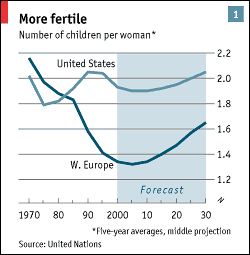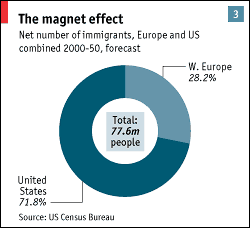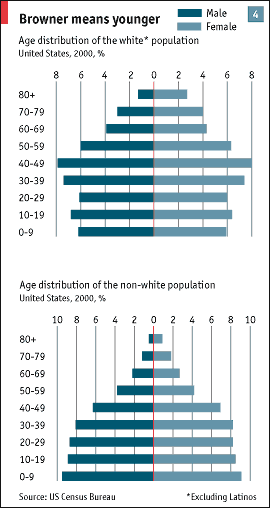|
| ||||||
|
| |
|
|
FORGET transatlantic rifts about trade, Iraq, Kyoto, or the International Criminal Court. These have been thoroughly ventilated. One area of difference has not got the attention it deserves: demography. It may prove the most important of all.
For 50 years, America and the nations of Western Europe have been lumped together as rich countries, sharing the same basic demographic features: stable populations, low and declining fertility, increasing numbers of old people. For much of that period, this was true. But in the 1980s, the two sides began to diverge. The effect was muted at first, because demographic change is slow. But it is also remorseless, and is now beginning to show up.
America's census in 2000 contained a shock. The population turned out to be rising faster than anyone had expected when the 1990 census was taken. There are disputes about exactly why this was (more on that shortly). What is not in doubt is that a gap is beginning to open with Europe. America's fertility rate is rising. Europe's is falling. America's immigration outstrips Europe's and its immigrant population is reproducing faster than native-born Americans. America's population will soon be getting younger. Europe's is ageing.
By 2040, perhaps earlier, America will overtake Europe in population |
Unless things change substantially, these trends will accelerate over coming decades, driving the two sides of the Atlantic farther apart. By 2040, and possibly earlier, America will overtake Europe in population and will come to look remarkably (and, in many ways, worryingly) different from the Old World.
In 1950, Western Europe was exactly twice as populous as the United States: 304m against 152m. (This article uses the US Census Bureau's definition of “Europe”, which includes all countries that were not communist during the cold war. The 15 countries that make up the European Union are a slightly smaller sample: they had a population of 296m in 1950.) Both sides of the Atlantic saw their populations surge during the baby boom, then grow more slowly until the mid-1980s. Even now, Europe's population remains more than 100m larger than America's.
In the 1980s, however, something curious began to happen. American fertility rates—the average number of children a woman can expect to bear in her lifetime—suddenly began to reverse their decline. Between 1960 and 1985, the American fertility rate had fallen faster than Europe's, to 1.8, slightly below European levels and far below the “replacement level” of 2.1 (the rate required to keep the population steady). By the 1990s American fertility had rebounded, rising back to just below the 2.1 mark.
Nobody quite knows why. Some of the recovery was the result of higher-than-average fertility among immigrants. But not all of it: fertility rose among native-born whites and blacks as well. Perhaps the most plausible, if unprovable, explanation is that higher fertility was the product of the economic boom of the 1990s combined with what one might call “social confidence”: America was a good country to bring more children into.
America is the world's great demographic outlier |
America is not unique: a few north-European countries, like Norway, have followed a similar trajectory. But it is highly unusual. Nearly every country in the world has seen its fertility rate fall recently and, by and large, the richer the country, the greater the fall. “America”, says Hania Zlotnik of the United Nations Population Division, “is the world's great demographic outlier.”
Meanwhile, Europe's fertility continues to fall. Having been just below 1.9 in the mid-1980s, the rate is now less than 1.4 and it is projected to continue declining for at least another ten years. In some countries—Spain, Italy and Greece—the fertility rate has fallen to between 1.1 and 1.3.
|
| |
 | |
|
|
It is fair to say that these numbers probably exaggerate the long-term demographic difference between the two sides. Remember that between 1970 and 1985 American fertility rates were slightly lower than Europe's. What seems to have happened then was not that Americans were having fewer children overall, but that a generation of women was postponing motherhood. That depressed America's birth rate in 1970-85, shifted a surge of births by half a generation, and produced an unusually high rate in the 1990s. That same population shift is happening in parts of Europe now, especially in those Mediterranean countries with the lowest fertility rates. There too, many women are merely postponing child-bearing. Later, after about 2010, when they have their children, Europe's fertility rate will nudge back up (see chart 1).
But what is striking about the American rate is not that it rose and fell, but that it rose so much—to within a whisker of the replacement level. And what is striking about the European rate is that it fell so far, to a much lower level than America's. That is also a reason for thinking it may not recover as strongly as America's did.
The UN reckons that the differences in fertility between America and Europe will continue over the next few decades. America's high rate is expected to remain relatively stable. Europe's should recover a bit—but it will not close the gap. The result of these differences, already evident in the census of 2000, will then become starker.
America's population should have been 275m in 2000. At least, that is what the central projection of the 1990 census predicted. The 2000 census showed it was actually 281m, higher even than the “high series” projection from 1990. Some of this may have been caused by things other than population change: improvements in counting, for instance. But not all. The new census showed that immigration was higher than expected, and that the birth rate of native-born Americans was up too.
|
| |
 | |
|
|
Those higher fertility rates will have a bigger impact as time goes on. By 2040, using the new census's “middle series” projection, America's population will overtake Europe's. This forecast has already proved too low. On the “high-series projection”, the crossing point occurs before 2030 (see chart 2). Admittedly, this projection is based on high assumptions about fertility rates—over 2.5 in 2025-50. But if this proves correct, Europe's population in 2050 would be 360m and falling, America's would be over 550m and rising. Half a billion people: in other words, America would be twice the size it is now. Europe would be smaller. Obviously, straight-line projections over 50 years need to be taken with plenty of salt. All the same, the numbers are startling.
European commissioners are fond of boasting that the European Union (EU) is the largest market in the world. They claim an equal status with the United States in trade negotiations as a result. Some also think that, because of this parity, the euro will one day become an international reserve currency to rival the dollar.
The balance of global economic power would be tilted in fundamental ways |
But assume, for a minute, that Americans remain, as they are now, about one-third richer per head than Europeans. The high-series projection implies that America's economy in 2050 would still be more than twice the size of Europe's—and something like that preponderance would still be there even if you assume that by then much of Central and Eastern Europe will have joined the EU. The balance of global economic power would be tilted in fundamental ways. With 400m-550m rich consumers, the American market would surely be even more important to foreign companies than it is today. And if so, American business practices—however they emerge from the current malaise—could become yet more dominant.
Part of the rise in the population has been driven by higher fertility. The rest comes from immigration. In the past decade, America has taken in over 11m immigrants. That compares with 6m in the 1970s and 7m in the 1980s. The real number of new immigrants may be even higher, since these figures may not account for all the estimated 8m-9m people who have slipped illegally into the country. Some may return home. Others may be thrown out. But those that remain contribute to the growing population both directly and indirectly (that is, through their children). The fertility rate for non-hispanic whites is just over 1.8, for blacks 2.1. For Latinos, it is nearly 3.0—higher than in many developing countries. From the point of view of the overall population, therefore, higher immigration counts twice over.
That is a reason why America's total population will continue to rise, though perhaps not as much as the highest estimates suggest. Many of the new migrants come from Mexico. If Mexico's own demographic pattern, with fast-falling fertility, is anything to go by, the fertility rate for American Latinos is also bound to fall, though it will still be quite high.
|
| |
 | |
|
|
Europe has had an immigration boom as well, of course. Indeed, in 1985-95, there were slightly more immigrants going into Europe than into America (though since Europe's population is larger, America's rate was higher). But more recently, the European numbers have fallen—presumably reflecting increased barriers to entry—and overall, since 1950, Europe has taken in far fewer people. Most demographers forecast that immigration will be much lower in Europe than in America during the next few decades (see chart 3).
The difference in immigration not only increases America's population compared with Europe's, it also makes it look increasingly different. Compare the different shapes of chart 4, which maps the age distribution of America's whites, on the left, and other groups, on the right. Whites form a pear shape: they are preponderant among adults. This is also the shape of Europe's population. Blacks and browns form a pyramid: children account for most of the population. Even now, in the parts of America with the highest immigration, such as Los Angeles and Houston, Latinos account for half of all children under 14. This is the characteristic shape of developing countries. As the bulge of Latinos enters peak child-bearing age in a decade or two, the Latino share of America's population will soar.
|
| |
 | |
|
|
That could have an impact both on economics and on geopolitics. The economic impact is clear enough. Kenneth Prewitt, the former head of the US Census Bureau, argues that “in the struggle to find workers to support growing economies, nations that are hospitable to immigrants will have an advantage.” Immigrants go where there are friends and family to welcome them and help them get jobs. Where will they find a more hospitable welcome—Europe or America?
The geopolitical impact is fuzzier, but still powerful. At the moment, America's political connections and shared values with Europe are still strong, albeit fraying. But over time, America's ties of family and culture will multiply and strengthen with the main sources of its immigration—Latin America chiefly, but also East and South Asia. As this happens, it is probable that it will also pull American attention further away from Europe.
Higher fertility rates and immigration produce not only a larger population but a society that is younger, more mixed ethnically and, on balance, more dynamic. The simplest expression of this is median age (by definition, half of the population is older than the median age, and half younger). According to Bill Frey, a demographer at the University of Michigan, the median age in America in 2050 will be 36.2. In Europe it will be 52.7. That is a stunning difference, accounted for almost entirely by the dramatic ageing of the European population. At the moment, the median age is 35.5 in America and 37.7 in Europe. In other words, the difference in the median age is likely to rise from two to 17 years by 2050.
Behind this change lie demographic patterns with big policy implications. The percentage of children in the population is falling as populations age. But in America it is falling more slowly than elsewhere. In 1985, America and Europe had more or less the same proportion of the population under 14 years of age: around 20%. By 2020, the proportion of children in Europe will have slumped to 13.7%. In America it will still be 18.6%—not only higher than in Europe but higher than in China and Japan, as well.
From a fiscal point of view, more children are not necessarily a blessing: their education is a burden on the public finances. Because America has relatively more children than Europe, its “dependency ratio”, or the number of children and elderly people for each working-age person, does not stay low. It is slightly higher than in Europe now—51% against 47%—and will stay just above European levels as the ratio rises in both places until about 2035 (see top panel of chart 5). But note the difference: a higher proportion of Europe's “dependency costs” comes from the old. The number of people over 65 will be equivalent to 60% of the working-age population in Europe in 2050, compared with only 40% in America. There, most of the overall burden will come from the cost of educating children (chart 5, bottom panel).
|
| |
 | |
|
|
You see the significance after 2035. In America, the dependency ratio will start to fall as the bulge of children turns into a bulge of adults. But in Europe there will be no such change, and the ratio will continue to rise. This is where the implications for public policy become large.
Both Europe and America face fiscal problems in providing pensions and health care as their baby-boomers retire. On some estimates, by 2050, government debt could be equivalent to almost 100% of national income in America, 150% in the EU as a whole, and over 250% in Germany and France. So while the burden is growing on both sides of the Atlantic, it is much heavier in Europe.
That is a problem in its own right, and a source of another long-term difficulty in the transatlantic relationship. Since the end of the cold war, Europe and America have made different calculations about where to spend public money. America has put more into defence; Europe has spent more on social programmes.
The long-term logic of demography seems likely to entrench America's power and to widen existing transatlantic rifts |
The result is a familiar military imbalance. America spends about twice as much on defence as the entire European Union ($295 billion in 2000, or 3% of GDP, compared with the EU's $153 billion), thus maintaining its preponderant military might. Europeans intermittently promise to spend more in order to narrow the military gap, recognising the dangers to the NATO alliance if they fail to pull their weight, but population trends will sap their determination.
If Europeans are unwilling to spend what is needed to be full military partners of America now, when 65-year-olds amount to 30% of the working-age population, they will be even less likely to do more in 2050, when the proportion of old people will have doubled. In short, the long-term logic of demography seems likely to entrench America's power and to widen existing transatlantic rifts.
Perhaps none of this is altogether surprising. The contrast between youthful, exuberant, multi-coloured America and ageing, decrepit, inward-looking Europe goes back almost to the foundation of the United States. But demography is making this picture even more true, with long-term consequences for America's economic and military might and quite possibly for the focus of its foreign policy.
| Copyright © 2002 The Economist Newspaper and The
Economist Group. All rights reserved. |